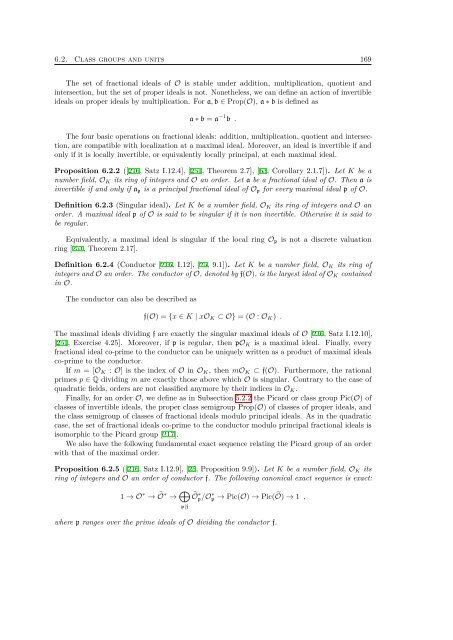here - Sites personnels de TELECOM ParisTech - Télécom ParisTech
here - Sites personnels de TELECOM ParisTech - Télécom ParisTech
here - Sites personnels de TELECOM ParisTech - Télécom ParisTech
Create successful ePaper yourself
Turn your PDF publications into a flip-book with our unique Google optimized e-Paper software.
6.2. Class groups and units 169The set of fractional i<strong>de</strong>als of O is stable un<strong>de</strong>r addition, multiplication, quotient andintersection, but the set of proper i<strong>de</strong>als is not. Nonetheless, we can <strong>de</strong>fine an action of invertiblei<strong>de</strong>als on proper i<strong>de</strong>als by multiplication. For a, b ∈ Prop(O), a ∗ b is <strong>de</strong>fined asa ∗ b = a −1 b .The four basic operations on fractional i<strong>de</strong>als: addition, multiplication, quotient and intersection,are compatible with localization at a maximal i<strong>de</strong>al. Moreover, an i<strong>de</strong>al is invertible if andonly if it is locally invertible, or equivalently locally principal, at each maximal i<strong>de</strong>al.Proposition 6.2.2 ([216, Satz I.12.4], [251, Theorem 2.7], [63, Corollary 2.1.7]). Let K be anumber field, O K its ring of integers and O an or<strong>de</strong>r. Let a be a fractional i<strong>de</strong>al of O. Then a isinvertible if and only if a p is a principal fractional i<strong>de</strong>al of O p for every maximal i<strong>de</strong>al p of O.Definition 6.2.3 (Singular i<strong>de</strong>al). Let K be a number field, O K its ring of integers and O anor<strong>de</strong>r. A maximal i<strong>de</strong>al p of O is said to be singular if it is non invertible. Otherwise it is said tobe regular.Equivalently, a maximal i<strong>de</strong>al is singular if the local ring O p is not a discrete valuationring [251, Theorem 2.17].Definition 6.2.4 (Conductor [216, I.12], [25, 9.1]). Let K be a number field, O K its ring ofintegers and O an or<strong>de</strong>r. The conductor of O, <strong>de</strong>noted by f(O), is the largest i<strong>de</strong>al of O K containedin O.The conductor can also be <strong>de</strong>scribed asf(O) = {x ∈ K | xO K ⊂ O} = (O : O K ) .The maximal i<strong>de</strong>als dividing f are exactly the singular maximal i<strong>de</strong>als of O [216, Satz I.12.10],[251, Exercise 4.25]. Moreover, if p is regular, then pO K is a maximal i<strong>de</strong>al. Finally, everyfractional i<strong>de</strong>al co-prime to the conductor can be uniquely written as a product of maximal i<strong>de</strong>alsco-prime to the conductor.If m = [O K : O] is the in<strong>de</strong>x of O in O K , then mO K ⊂ f(O). Furthermore, the rationalprimes p ∈ Q dividing m are exactly those above which O is singular. Contrary to the case ofquadratic fields, or<strong>de</strong>rs are not classified anymore by their indices in O K .Finally, for an or<strong>de</strong>r O, we <strong>de</strong>fine as in Subsection 5.2.2 the Picard or class group Pic(O) ofclasses of invertible i<strong>de</strong>als, the proper class semigroup Prop(O) of classes of proper i<strong>de</strong>als, andthe class semigroup of classes of fractional i<strong>de</strong>als modulo principal i<strong>de</strong>als. As in the quadraticcase, the set of fractional i<strong>de</strong>als co-prime to the conductor modulo principal fractional i<strong>de</strong>als isisomorphic to the Picard group [217].We also have the following fundamental exact sequence relating the Picard group of an or<strong>de</strong>rwith that of the maximal or<strong>de</strong>r.Proposition 6.2.5 ([216, Satz I.12.9], [25, Proposition 9.9]). Let K be a number field, O K itsring of integers and O an or<strong>de</strong>r of conductor f. The following canonical exact sequence is exact:1 → O ∗ → Õ∗ → ⊕ p|fÕ ∗ p/O ∗ p → Pic(O) → Pic(Õ) → 1 ,w<strong>here</strong> p ranges over the prime i<strong>de</strong>als of O dividing the conductor f.
















